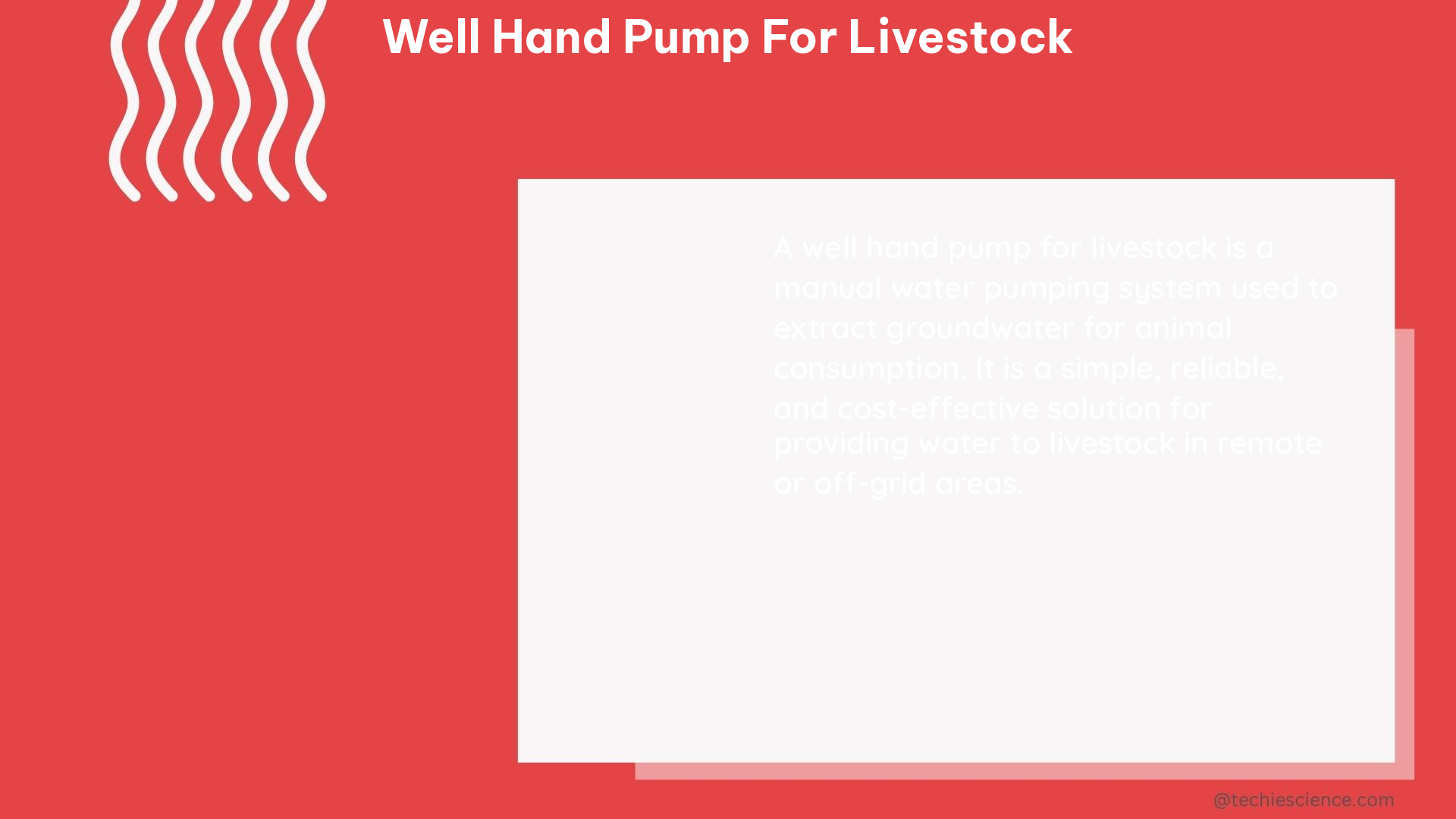When it comes to providing a reliable water source for your livestock, a well-designed hand pump can be an invaluable asset. This comprehensive guide delves into the key considerations and technical details you need to know when selecting and installing a well hand pump for your livestock operation.
Flow Rate: Ensuring Adequate Water Delivery
The flow rate of a hand pump is a critical factor in determining its suitability for livestock watering. For optimal performance, a hand pump for livestock should have a minimum flow rate of 3-5 gallons per minute (GPM). This flow rate ensures that your animals can quickly and efficiently access the water they need, even during peak demand periods.
To achieve this flow rate, the pump’s internal components, such as the cylinder size and piston design, must be carefully engineered. For example, a larger cylinder diameter can increase the volume of water drawn with each stroke, while a well-crafted piston can minimize friction and maximize the pump’s efficiency.
Lift Capacity: Reaching the Water Source

The lift capacity of a hand pump refers to the maximum vertical distance it can draw water from the well. This is a crucial consideration, as the depth of your well will determine the pump’s suitability.
Pitcher pumps, which use a suction mechanism, are typically limited to a maximum lift of around 25 feet. In contrast, suction pumps, which rely on a combination of suction and positive displacement, can lift water from depths of up to 10 feet.
When selecting a hand pump, it’s essential to carefully measure the depth of your well and choose a model with a lift capacity that exceeds this depth by a comfortable margin. This will ensure reliable and consistent water delivery, even as the water table fluctuates over time.
Durability: Withstanding the Elements
Livestock hand pumps must be designed to withstand the rigors of heavy use and exposure to the elements. The choice of materials used in the pump’s construction is a key factor in determining its durability.
Stainless steel and cast iron components are often preferred for their resistance to corrosion and wear, ensuring a longer lifespan for the pump. In contrast, pumps with plastic or other less durable materials may require more frequent maintenance and replacement of parts.
Additionally, the pump’s seals and gaskets should be made from high-quality, weather-resistant materials to prevent leaks and maintain optimal performance, even in harsh outdoor conditions.
Maintenance Requirements: Keeping the Pump in Top Shape
Regular maintenance is essential for ensuring the long-term reliability of a hand pump for livestock. This may include:
- Lubrication: Periodic lubrication of moving parts, such as the pump rod and bearings, helps to reduce friction and wear, extending the pump’s lifespan.
- Component Replacement: Replacing worn or damaged components, such as seals, valves, and piston cups, is crucial for maintaining the pump’s efficiency and preventing leaks.
- Cleaning: Regularly cleaning the pump mechanism, including the cylinder and suction pipe, helps to prevent the buildup of mineral deposits or debris that can impede the pump’s operation.
To simplify maintenance, look for hand pumps with easy-to-access components and clear instructions for servicing. This will make it easier for livestock owners to perform routine maintenance tasks and keep the pump in top working condition.
Ease of Use: Prioritizing Operator Comfort
Livestock hand pumps should be designed with the user in mind, ensuring that they are easy to operate even for those who may not be familiar with pump mechanics.
Features such as large, ergonomic handles or levers can make it easier to generate the necessary force to draw water. Clear markings indicating the water level and easy-to-read gauges or indicators can also help users monitor the pump’s performance and identify any issues that may arise.
Additionally, the pump’s overall design should minimize the physical effort required to operate it, reducing the strain on the user and making the task of watering livestock more manageable.
Cost Considerations: Balancing Initial and Ongoing Expenses
The cost of a hand pump for livestock can vary widely, depending on factors such as the materials used, the pump’s capacity, and the complexity of the installation.
When evaluating different pump options, it’s essential to consider not only the initial purchase price but also the ongoing maintenance and repair costs. Pumps made with higher-quality, more durable components may have a higher upfront cost but may ultimately prove more cost-effective in the long run due to their reduced maintenance requirements and extended lifespan.
Additionally, the complexity of the installation, including any necessary well modifications or infrastructure upgrades, can also impact the overall cost of the hand pump system.
Conclusion
Selecting the right well hand pump for your livestock operation requires careful consideration of a range of technical factors, from flow rate and lift capacity to durability and maintenance requirements. By understanding these key considerations and prioritizing the specific needs of your livestock, you can ensure that your hand pump provides a reliable and efficient water source for years to come.
References
- Draft Guidelines for Field Evaluation of Handpump Projects
- Understanding handpump sustainability: Determinants of rural water sources in Ghana
- Hand-pumps as reservoirs for microbial contamination of well water

The lambdageeks.com Core SME Team is a group of experienced subject matter experts from diverse scientific and technical fields including Physics, Chemistry, Technology,Electronics & Electrical Engineering, Automotive, Mechanical Engineering. Our team collaborates to create high-quality, well-researched articles on a wide range of science and technology topics for the lambdageeks.com website.
All Our Senior SME are having more than 7 Years of experience in the respective fields . They are either Working Industry Professionals or assocaited With different Universities. Refer Our Authors Page to get to know About our Core SMEs.